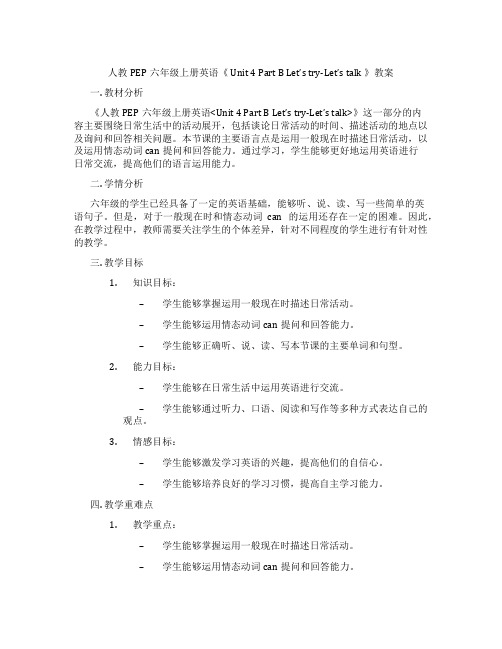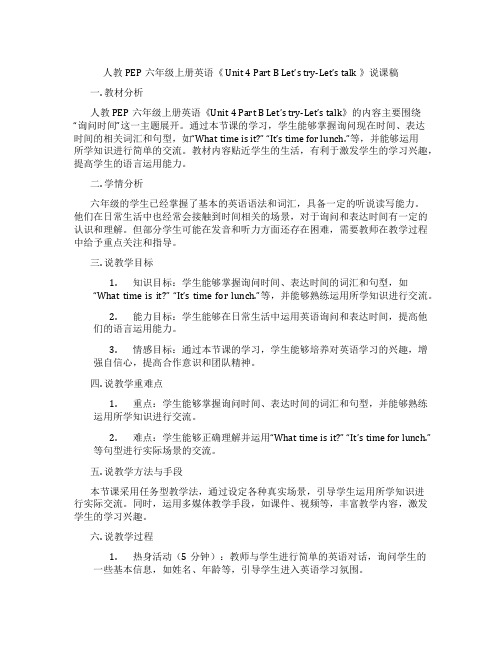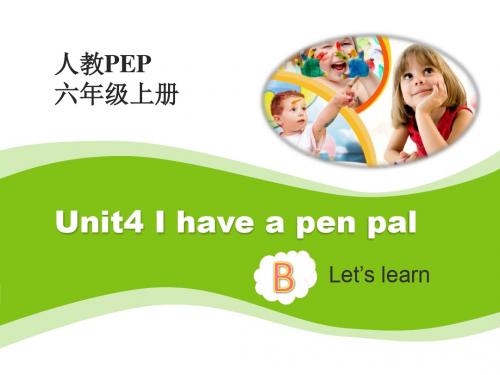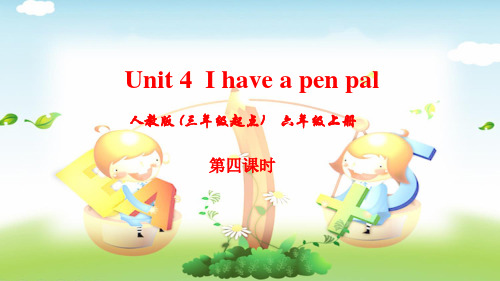六年级上册英语unit4 B let'sread
人教PEP六年级上册英语《Unit4PartBLet'stry-Let'stalk》教案

人教PEP六年级上册英语《Unit 4 Part B Let’s try-Let’s talk 》教案一. 教材分析《人教PEP六年级上册英语<Unit 4 Part B Let’s try-Let’s talk>》这一部分的内容主要围绕日常生活中的活动展开,包括谈论日常活动的时间、描述活动的地点以及询问和回答相关问题。
本节课的主要语言点是运用一般现在时描述日常活动,以及运用情态动词can提问和回答能力。
通过学习,学生能够更好地运用英语进行日常交流,提高他们的语言运用能力。
二. 学情分析六年级的学生已经具备了一定的英语基础,能够听、说、读、写一些简单的英语句子。
但是,对于一般现在时和情态动词can的运用还存在一定的困难。
因此,在教学过程中,教师需要关注学生的个体差异,针对不同程度的学生进行有针对性的教学。
三. 教学目标1.知识目标:–学生能够掌握运用一般现在时描述日常活动。
–学生能够运用情态动词can提问和回答能力。
–学生能够正确听、说、读、写本节课的主要单词和句型。
2.能力目标:–学生能够在日常生活中运用英语进行交流。
–学生能够通过听力、口语、阅读和写作等多种方式表达自己的观点。
3.情感目标:–学生能够激发学习英语的兴趣,提高他们的自信心。
–学生能够培养良好的学习习惯,提高自主学习能力。
四. 教学重难点1.教学重点:–学生能够掌握运用一般现在时描述日常活动。
–学生能够运用情态动词can提问和回答能力。
2.教学难点:–学生能够正确运用一般现在时和情态动词can进行实际交流。
五. 教学方法1.情境教学法:通过设定真实的生活情境,让学生在实际语境中学习、运用英语。
2.任务型教学法:通过完成各种任务,激发学生的学习兴趣,提高他们的实践能力。
3.合作学习法:引导学生进行小组合作,培养他们的团队精神和沟通能力。
4.游戏教学法:通过设计有趣的游戏,让学生在轻松愉快的氛围中学习英语。
六. 教学准备1.教学材料:教材、多媒体课件、录音机、磁带、相关图片等。
新人教版六年级英语上册Unit4_B_Let's_learn

Does he live in…? Yes, he does.
No, he doesn’t.
John
What’re John’s hobbies?(小 组讨论)
He likes……
John
study Chinese 学习汉语
John
study
study
Chinese
三单 studies
Lisa comes from Japan, but she lives in China now. what does she often do?
My pen pal Lisa(小组合作读短文) I have a pen pal. Her name is Lisa. She comes from Japan. But she lives in Beijing now. she is 21years old. She studies Chinese in Peking University. Lisa likes China very much. She likes everything about China. She cooks Chinese food at home and she makes Chinese tea every day. She is going to learn Chinese kung fu next year. She likes doing word puzzles. So she often does word puzzles with her Chinese friends. On the weekend, she sometimes goes hiking. Do you like Lisa? Do you want to be her pen pal?
新课标PEP小学英语六年级上册《unit4BLet`sread》精品教案

新课标 PEP 小学英语六年级上册《unit 4 B Let`s read》精品教案一Pre-reading1.Let`s sing.T:Boys and girls, can you sing the song?Now, let`s sing the song like this.2.T: Boys and girls, let`s see some beautiful girls.Are they twin sisters?Ss: ⋯.T: If you think they are twin sisters, put up your hands, please.如果你觉得她们是双胞胎, 请举手。
Let`s see.No, they are not twin sisters.She is Pan Chen, and she is Teng Ye.They look the same.Let`s see more about them.Pan Chen is a Chinese, but Teng Ye is a Japnese.Pan Chen is a model, but Teng Ye is an actress.So they are very different.T:What about them?Are they twin sisters?No, they are not twin sisters.She is Yu Kewei and she is Yan Ni.They look the same.Yu Kewei is 22, but Yan Ni is 38.Yu Kewei is a singer, but Yan Ni is an actress.So they are very different.T:How about them?Are they twin sisters?Look carefully !Yes or no?They look the same.Let`s see.Oh, no, they are not twin sisters.She is Jiang Yingrong and she is Hu Ke.Jiang Yingrong is a singer.She is the No.1 of the Happy Girl in 2009.09 年快乐女生 No.1, 总冠军!I like her very much.Hu Ke is a famous actress.They are very different.Let`s see more about the two beautiful girls.3.复习一般疑问句肯定和否定式回答T:Does Jiang Yingrong go to work on foot?Ss: Yes, she does.T:Does Jiang Yingrong read newspapers in the evening?Ss: Yes, she does.T:Does Jiang Yingrong go to a park on Saturday?Ss: Yes, she does.T:Does Hu Ke go to work on foot?Ss: No, she doesn`t. She goes by car.T:Does Hu Ke read newspapers in the evening?Ss: No, she doesn`t.She watches TV.T:Does Hu Ke go to a park on Saturday?Ss: No, she doesn`t.She swims with her friends.二In-reading1.Genel-readingT:Do you know friends?Ss: Yes.T:Today we will learn a passage about friends.Open your books and turn to page 51.‘My New Friend ’by Liu Yun.Boys and girls, please read the passage quickly and try to answer the two questions.Here is the learning tip.T: Where does Alice live?Ss: She lives in Australia.T:What does her father do?Ss: He is teacher.T:He works in ⋯. He goes to school by⋯.What does Alice mother do?Ss: She is a nurse.T:She works in a ⋯. She goes to work by⋯.Let`s say together.Alice lives in Australia.Her father is ⋯. Her mother is ⋯.Who will have a try and say something about Alice, her father and her mother?S0: ⋯.2. T: OK, let`s see the questions on our books.Now, read the passage and try to answer the five questions.Here is the learning tip.OK? let`s go!T: Now, let`s check.T:Boys and girls, look at the screen, please.Can you?纠错Ss: ⋯.T:Now, exchange with your partners and check. 3.Read and write.T:Alice and her twin sister Ann, they look the same.Are they the same in everything?Take out the board, please.Now work in your groups.T:Great!三Post reading1.T: Put away the boards, please.T: Follow the tape.2.T: Why?Why is Liu Yun excited?Because Amy`s family is going to China! 简笔画Read by yourselves.过会我们开火车来读,看谁读的最好, 好不好?3. T: Boys and girls, close your books, please.Let`s retell the passage.Here is the learning tip.Let`s retell together.S0: ⋯.T:Very good!Let`s chant it.4.T: You did an excellent job!5.T: Jiang Yingrong sings very well.I like singing.So I like her very much.I want to make friends with her.How can I do?Ss: Write emails.T: Yes.Using emails, we can make friends with an American girl, or an England boy. Maybe she is from Korea, or from Australia. Maybe she is happy, or sad. Maybe he like reading, dancing or singing. Maybe they are white. Or they are black. Anyway, children all of the world are goodfriends.6. T: At last, your homework.。
人教PEP六年级上册英语《 Unit 4 Part B Let's try-Let's talk 》

人教PEP六年级上册英语《Unit 4 Part B Let’s try-Let’s talk 》说课稿一. 教材分析人教PEP六年级上册英语《Unit 4 Part B Let’s try-Let’s talk》的内容主要围绕“询问时间”这一主题展开。
通过本节课的学习,学生能够掌握询问现在时间、表达时间的相关词汇和句型,如“What time is it?” “It’s time for lunch.”等,并能够运用所学知识进行简单的交流。
教材内容贴近学生的生活,有利于激发学生的学习兴趣,提高学生的语言运用能力。
二. 学情分析六年级的学生已经掌握了基本的英语语法和词汇,具备一定的听说读写能力。
他们在日常生活中也经常会接触到时间相关的场景,对于询问和表达时间有一定的认识和理解。
但部分学生可能在发音和听力方面还存在困难,需要教师在教学过程中给予重点关注和指导。
三. 说教学目标1.知识目标:学生能够掌握询问时间、表达时间的词汇和句型,如“What time is it?” “It’s time for lunch.”等,并能够熟练运用所学知识进行交流。
2.能力目标:学生能够在日常生活中运用英语询问和表达时间,提高他们的语言运用能力。
3.情感目标:通过本节课的学习,学生能够培养对英语学习的兴趣,增强自信心,提高合作意识和团队精神。
四. 说教学重难点1.重点:学生能够掌握询问时间、表达时间的词汇和句型,并能够熟练运用所学知识进行交流。
2.难点:学生能够正确理解并运用“What time is it?” “It’s time for lunch.”等句型进行实际场景的交流。
五. 说教学方法与手段本节课采用任务型教学法,通过设定各种真实场景,引导学生运用所学知识进行实际交流。
同时,运用多媒体教学手段,如课件、视频等,丰富教学内容,激发学生的学习兴趣。
六. 说教学过程1.热身活动(5分钟):教师与学生进行简单的英语对话,询问学生的一些基本信息,如姓名、年龄等,引导学生进入英语学习氛围。
新人教(PEP)六年级英语上册《Unit4 B let's read》精品教案.doc

《Unit4 B let's read》精品教案第六课时一、教学内容本课时的教学内容是人教版小学英语六年级上册Unit Four I have a pen pal. B. Let’s read C. Let’s check二、教学目标1.能够听、说、认读句子:They are very different.2.能够完成Let's check部分的练习。
三、教学重难点本课时教学重点和难点是理解Let's read中的短文。
四、教学准备1.教师准备录音机及录音带。
2.教师准备A、B部分Let's learn的单词卡片和B Let's read的挂图。
五、教学过程Step Ⅰ. Leading –in1、Let’s sing:Where are you going ? (师生一起拍手唱)2、Let’s chant:Tell me about your pen pal. (跟录音有节奏地说唱)3、Daily talk:E.g.: Good morning. How are you today?How do you go to school?Does your father go to work by bus?What does your mother do?Does she watch TV at night?4、Games.⑴Missing game.教师先出示三张图片,学生读一遍后把其中的一张拿走,请学生说出被拿走的图片。
⑵Guessing game.个别学生做动作,其他学生根据动作猜出动词词组。
Step Ⅱ. Pre –task and while –task1、提出主任务,阅读课文内容。
T:“Do you remember Liu Yun’s pen pal Alice ? Do you want to know Alice and her family ?”引导学生给出肯定回答后,教师接着说:“I have a VCD, Let’s watch it together. But Liu Yun asks me some questions. Can you answer them for me ? ”引导学生给出肯定回答后出示主任务:Main tasks: Do Alice and her twin sister loo k the same?Do they have the same hobbies ?T: “Please watch carefully and think it over. And then answer the questions.Now, let’s watch it.”播放VCD。
PEP六年级上册英语第四单元B部Let'stalk

She likes doing kung fu. What are you going to do?
Does he like going hiking? Can I also be his pen pal?
Really,?Does he like doing word puzzles and going hiking ? ?
singing singing , I like singing
Free talk
• What’s your hobby?
你的爱好是什么?
• Do you have a pen pal?
你有一个笔友吗?
• Does he/she live Yueyang?
他/她住在岳阳吗?
• How old is he/she?
“借” 原” No, he doesn’t.(否定回答)
★
like doing sth
喜欢做某事
★★
like
likes
live lives
(第三人称单数形式)
★★★
She likes dancing.变一般疑问句
遵循一“借”二 “还原”
Does she like dancing?
Yes, she does.(肯定回答)
No, she doesn’t.(否定回答)
I like reading stories.
Do you like ……?
Yes, I do.(肯定回答) No, I don’t.(否定回答)
He likes reading stories.
Does he like ……?
一
二“还 Yes, he does.(肯定回答)
Questions?
人教PEP版小学英语六年级上册Unit4 B Let’s learn课件

>>Presentation
规律总结
动词变第三人称单数的规则
1. 直接加-s sings reads
play s
say s
2. 以s, x, ch, sh, 或o结尾的,加-es. teach- teaches go- goes do- does
3. 以辅音字母加y结尾的动词,把y变为i加-es. study- studies
go hiking
do kung fu
play football
>>Presentation
John has a new pen pal. What’s his pen pal’s name?
What do you know about him?
>>Presentation
Name:___J_o_h__n____ From:___A__u_s_t_ra__li_a
人教PEP 六年级上册
Unit4 I have a pen pal
Let’s learn
>>Warm-up
Let’s sing
(单击图片可播放动画)
>>Warm-up
Free talk
What’s your hobby?
I like …
cook
read stories
sing dance
Live in:__C__a_n_b_e_r_ra_ Age:___1_1_y_e_a_r_s_old Hobbies:_________
>>Presentation
do does word puzzles He does word puzzles.
PEP六年级上册第四单元B部分

Festival, Christmas Day
词汇拓展与运用
与月份相关的表达
in January (在一月), on the first day of the month (在月初), at the end of December (在十二月底)
与序数词相关的表达
my birthday is on the fifth of May (我的生日在五月五日), it's the third time he has been late this week (这是他本周第三次迟 到)
选择适合年级和水平的阅读材料
选择符合六年级学生认知水平和语言能力的阅读材料,确保学生能够理解并享 受阅读过程。
预览文章内容和结构
在阅读前,先快速浏览文章标题、副标题、图片和首段,了解文章主题和大致 内容,有助于后续深入阅读和理解。
阅读方法指导
略读法
通过快速浏览文章,抓住文章大意和 中心思想,培养学生快速获取信息的 能力。
精读法
深入阅读文章,理解作者观点、情感 和态度,分析文章结构和语言特点, 提升学生阅读理解和分析能力。
寻读法
针对问题或关键词,在文章中寻找相 关信息,提高学生查找细节和理解上 下文的能力。
阅读理解练习
理解文章主旨和中心思想
通过阅读文章,学生能够概括出文章的主要 内容和中心思想。
理解作者观点和态度
通过阅读文章,学生能够理解作者的观点、 情感和态度,并能够进行简单的评价。
02
词汇学习与拓展
重点词汇梳理
01
月份
January, February, March, April, May, June, July, August,
September, October, November, December
PEP版英语六年级上册Unit 4 Part B Let's try-Let's talk

( C )2. ______Peter ______in Beijing?
A. Do;live
B. Do;lives
C. Does;live
( C )3.He likes ______ chess, so he ______ chess every day.
A. play; playing B. plays ; playing
27
Unit 4 I have a pen pal
人教版 (三年级起点) 六年级上册
第四课时
Let’s sing!
Shaking Shaking Shaking shaking with your head Shaking shaking to the side Shining shining your shoulders Up and down to Round round hands and hips Round round to the side Wrinkle wrinkle your bottles To the left and right Stretch your arms open the wine Circles yours like some leaves
—他住在悉尼吗? —不,他不是。
Does he like doing word puzzles and going hiking?
Yes, he does.
—他喜欢做文字谜语和远足吗? —是的,他是。
点击“Let's try”,跟我 一起练听力吧!
Let's try
√ √
点击“Let's talk”,跟我 一起读课文吧!
Now circle your wings backwards Circle circle Put your hands on top your knees Circle yours like some leaves One two three four circle more Circle circle Stock on stomping your place Stock on stomp at your legs Open winds like butterflies Clapping and happy
PEP六上Unit 4 B Let's learn

She reads newspaper.
She watches TV.
Let’s listen
填空(注意单三形式) goes ______ teaches English _______to work by____ bus ______TV at night watches _____newspaper every day reads Does live ______your pen pal _____in Shanghai? lives No,he doesn’t.He ______in Beijing.
Answer these questions
1. Does your father read a newspaper ? Yes, he does. No, he doesn’t.
2. Does your mother teach English? Yes, she does. No, she doesn’t.
Liu Yun and Alice are pen pals. Liu Yun lives in China. Alice is in Australia. Alice has a twin sister. Alice likes sports. Her sister likes art. Liu Yun likes playing the violin and writing e-mails. Her father is a TV reporter. He likes listening to music. Her mother is a singer. She likes swimming.
He lives in Beijing .
小学人教PEP版英语六年级上册Unit4 B Let’s talk名师教案

教材版本:PEP小学英语六年级上册第四单元2. Free talk:T: Do you have a pen pal? What are his/her hobbies? Where are they come from?If you have a pen pal, what do you want to know about him or her? Name hobbyCity age请一名学生介绍他笔友的有关情况,如:I have a pen pal. She lives in Beijing. I live in Wuhan. She likes climbing mountains, singing and swimming, but I like drawing cartoons and dancing. We often write emails.根据这名学生的介绍问其他学生:Does his pen pal live inBeijing/Wuhan …?引导学生回答:Yes, he/she does./No, she does n’t. She lives in …T: Wu Y ifan has a new pen pal. Let’s see what he is like.二、呈现新课(Presentation)Step 2:Presentation1. Let’ s try引导学生看问题,What are Miss White and Wu Yifan talking about? How old is the student?播放Let’s try部分的录音,学生找出关键信息。
再次播放录音,核对答案。
最后让学生尽量听出原文并进行复述。
Let’s talk2. 播放Let’s talk部分的录音,听两遍录音后回答问题。
①What is Wu Yifan doing?②Where does Wu Yifan’s pen pal live?③What do the two Johns like?引导学生回答问题,并答疑。
- 1、下载文档前请自行甄别文档内容的完整性,平台不提供额外的编辑、内容补充、找答案等附加服务。
- 2、"仅部分预览"的文档,不可在线预览部分如存在完整性等问题,可反馈申请退款(可完整预览的文档不适用该条件!)。
- 3、如文档侵犯您的权益,请联系客服反馈,我们会尽快为您处理(人工客服工作时间:9:00-18:30)。
1、熟读课文二遍。
2、以My Friend为题写 一篇作文。介绍你朋友 的父母,他们的职业, 去上班的交通方式,以 及爱好等等。不少于50 词。
Sarah is my good friend. She lives in Baishi. Her father is a doctor. He works in a hospital. He goes to work by bus. He likes playing football. Her mother is teacher. She works in a school. She goes to work on foot. She likes listening to music and watching TV. This is my friend. Can you tell me something about your friend?
Tips3:分段读,抓住关键词。 利用关键词复述课文。
Alice is my _______. Shelives in Australia.Her _____ friend fatherworks in a school. He is ateacher goes to _____ ______.He _____ by work ____ bus.Her mother is a nurse. She works in a hospital .She goes to work _____ _____by car.Alice and her sister are twins They look ______. _____the same,but they are different. I write an ____Email to Alice every ___ week.Alice says her family is _______ to China. I am coming _______. excited
1.Does Alice go to school by bus? . No, she doesn’t
She goes to school by bike.
2.Does her father work in a hospital No, she doesn’t .
Her father works in a school.
I read newspapers every day. Do you read newspapers every day? Yes, I do. No, I don’t. He reads newspapers every day. Does he read newspapers every day? Yes, he does. No, he doesn’t.
Alice is my new friend. She lives in Australia. Her father works in a school. He is a teacher. He goes to work by bus. Her mother is a nurse. She works in a hospital. She goes to work by car. Alice and her sister are twins. They look the same, but they are very different. Every morning, Alice goes to school by bike, but Ann goes to school on foot. Every evening, Alice reads newspapers. Her sister Ann watches cartoons on TV. Alice usually plays at the park on Saturdays. Ann usually makes kites. I write an email to Alice every week. Alice says her family is coming to China soon. I am excited.
3.Does he go to work by bus? Yes, he does .
4.Does Ann go to school by bike? . No, she doesn’t
Ann goes to school on foot.
5.Does Alice read newspapers every evening? Yes, she does.
I watch TV at night. Do you watch TV at night? Yes, I do. No, I don’t. He watches TV at night. Does he watch TV at night? Yes, he does. No, he doesn’t.
Tips2: 听录音,看课文。找出并用横线划出新单 词。 live in Australia 居住在澳大利亚 work in a school 在学校工作 look the same看起来一样 different 不同的 every morning / week 每天早上/星期 watch cartoons on TV 看卡通片 write an email 写一个邮件 says 说 soon 不久 excited 兴奋的;激动的
How do you go to school? I go to school by car. How does she/ he go to school? She/he goes to school by bus. on foot by bike …
by bike
by bus by train by subway
My Friend
by plane
by ship
on foot
What’s your hobby I like…
大家一起来造句吧~
I like painting. Do you like painting? Yes, I do. No, I don’t. She likes painting. Does she like painting? Yes, she does. No, she doesn’t.
live in the country lives in the country I live in the country. She lives in the country.
I live in the country. Do you live in the country? I live in the city. Do you live in the city? She lives in the country. Does she lives in the country? She lives in the city. Does she live in the city?
I live in Yongkang. Do you live in Yongkang? Yes, I do. No, I don’t.
She lives in Gushan. Does she live in Gushan? Yes, she does. No, she doesn’t.
live in the city lives in the city I live in the city. She lives in the city.
I teach English. Do you teach English? Yes, I do. No, I don’t He teaches English. Does he teach English? Yes, he does. No, he doesn’t.
I go to work by bus. Do you go to work by bus? Yes, I do. No, I don’t. She goes to work by bus. Does she go to work by bus? Yes, she does. No, she doesn’t.
